Do-it-yourself deepening of the well: a review of the best methods to get to the aquifer
Well, from ancient times used by mankind. The technology of their construction has been honed for centuries and almost unchanged. The problems faced by the owners of such facilities remain unchanged. One of the most common is a decrease in the amount of water.
Often, her only solution is to deepen the wells to the next aquifer. We will describe how and how to deepen water intake. You will find out what you need to stock up for work.
The content of the article:
Well design and construction
The design of the well has not changed for hundreds of years. The structure is a shaft, the bottom of which is located in the aquifer.
The walls of the trunk are strengthened from shedding. For these purposes, stone, wood or a modern version can be used - reinforced concrete rings. Usually settles down at the bottom filter, which is a backfill of gravel 10-15 cm high. There are more complex multilayer filters consisting of crushed stone, gravel and sand.
The mine is closed by the so-called super-well house, in which there is a mechanism for lifting water. The construction can be equipped with a pump, which greatly facilitates the supply of water.
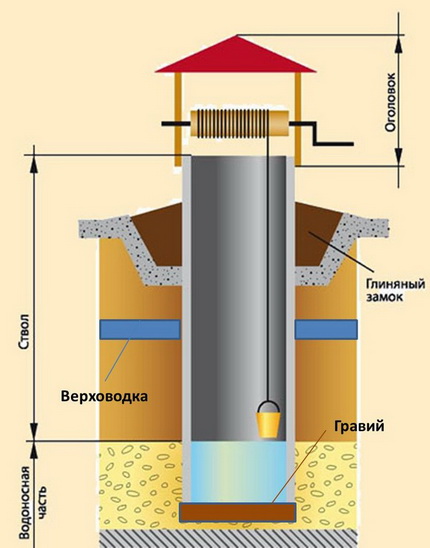
The main "competitor" of the well is considered to be a well. Each source has its own strengths and weaknesses. In order to choose the best option for you personally, we suggest that you familiarize yourself with comparative review.
However, despite the advantages of the well, many prefer a traditional source of water. With proper operation, the well will last longer than it, while maintaining cleanliness in a mine is much easier than in a tubular borehole.
A construction with a manual water lifting mechanism does not need electricity and can be operated in any conditions, while a well pump is always volatile. In addition, the well can be dug up and equipped manually, without involving special equipment and mechanisms. However, trouble-free well operation is rare.
Reasons for leaving the well
The water level in the well may not be constant. It depends on a combination of many factors that are independent of the owner of the structure.
In the first place are the hydrogeological conditions of the area. Prolonged drought in the summer and severe frosts in the winter can lead to a complete drying out of the well. This is completely normal and does not require any human intervention.

Practice shows that after some time the water will return. Most often, those who dug their wells in early summer suffer from the consequences of this phenomenon.
At this time, there is a peak in the rise of the vodkhovodka, which makes it erroneously stop work, not reaching the real aquifer. Therefore, experts insistently recommend digging a new well in the dry period or in late autumn, and even better - in March, before the snow melts.
It often happens that a limited aquifer gradually dries up. Especially if he does not have regular recharge, and the operation was quite active. In this case, the question is ripening, which is better: deepen the old well or build a new source. In most cases, it is more rational to deepen as the least expensive activity.
They do the same in the event of a sharp decrease in groundwater level in a given area. This occurs if the aquifer or lens cannot be fueled by precipitation. In addition, the well bottom may become silty, which makes it impassable for water and makes it look for other ways to exit.
It also happens that the rainfall is normal, but there is still no water in the well. In this case, the cause may be the appearance in the immediate vicinity of a new well or well with impressive water mobility, which can temporarily "divert" water.
In this case, you need to wait four to five weeks, if the water level has not recovered, you will have to deepen the well shaft.
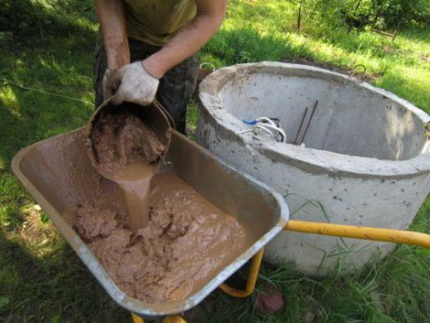
And another reason for the disappearance of water may be the wear of the materials of the water receiving part of the well trunk. In this case, water will flow weakly due to capillary channels clogged with destroyed material.
They also, it happens, are very strongly clogged by dense silt and sandy sediment, which is difficult to distinguish under the water column and remove. To free the water intake from pollution, you will need well cleaningrepair and its complete sealing.
Deepen or not deepen?
Deepening a dried-up well with your own hands is a very difficult and costly task, both in time and in money. That is why it is extremely important to determine the feasibility of a future event.
First of all, you need to answer a few questions:
- The decrease in the amount of water in the well cannot be related to the weather: prolonged frosts or prolonged drought.
- The water remaining in the well has retained its qualities.It has no odors, tasty and clean. If this is not the case, siltation of the bottom filter is possible. The problem is solved by competent cleaning.
- In nearby wells, the water level has not changed.
If all the questions are answered in the affirmative, it is entirely possible that the problem is in your well, and it needs to be deepened. But hurry up with the start of work anyway.
To begin with, it makes sense to conduct such events:
- conduct geological exploration through a survey of neighbors - owners of wells or wells;
- accurately determine the daily flow of water;
- to find out in the weather service or from the owners of the exploited water sources at what depth the aquifer has been opened;
- determine the ability of the soil to "hold" the walls of the shaft without precipitation.
Such time-consuming preparatory work is associated with the fact that all types of soil have their own characteristics and are characterized by certain nuances during work. Violation of the technology and incompetence of the employee may result in the closure of the aquifer, and even the destruction of the trunk when it enters the quicksand.

Quicksand is called soil, consisting of a water-saturated mixture of sand, organics and silt, which, under certain conditions, moves, which is dangerous not only for the well, but also for nearby buildings.
Errors in deepening a well shaft can be too expensive, both in terms of labor and money. The procedure can be carried out only once and in case of failure the well will only have to fall asleep.
At the same time, the cost of a new well dug nearby can in some cases be less than the deepening of the old one, and no one will guarantee success.
Experts recommend deepening the mine if there are several conditions:
- There is no quicksand at the bottom of the trunk.
- The well shaft is very deep, at least 10 rings. Otherwise, the construction of a new structure will cost less.
- Good water quality at source.
- No deformation of concrete rings inside the barrel. If there are displacements, their value does not exceed 40 mm.
- The daily debit of water is less than one ring.
The well will have to be deepened to the second aquifer. This is at least 5 meters, and there are no guarantees that the water in it is suitable for drinking.
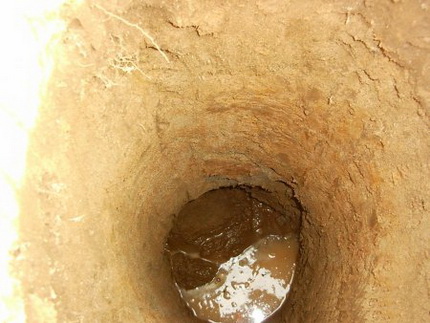
Advantages and disadvantages of different methods
There can be several options according to which you can deepen a dry well in a country house. Consider each of them and find out all the advantages and disadvantages of each.
Deepening with smaller rings
The method involves building the shaft from below with repair rings of smaller diameter. The main advantage of this method is the speed and minimum cost of its arrangement.
What are the "pitfalls"? First of all, you need to understand that the most common diameter of concrete rings for equipping a well is 1 m. Thus, it will be possible to choose parts with a diameter of 0.8, or even 0.6 m, as repair ones.
It is quite difficult to buy such factory-made rings; the quality of products manufactured by private owners can be very different.
Another difficulty is that before lowering the repair ring, you will have to cut the brackets off the main rings. Thus, the well will be left without a ladder, which is quite inconvenient. In addition, repair rings are extremely rarely equipped with brackets.
Thus, a well of many meters depth is left without a ladder, which in itself is a problem. Another nuance: the narrower the structure, the more difficult it is to work in it.
The ring, with a diameter of 0.8 m, is very inconvenient for work, with a diameter of 0.6 m - practically unsuitable. This applies to concrete rings, but there is another option for deepening with plastic items. It must be understood that the stiffness of the plastic in this case will be clearly insufficient.
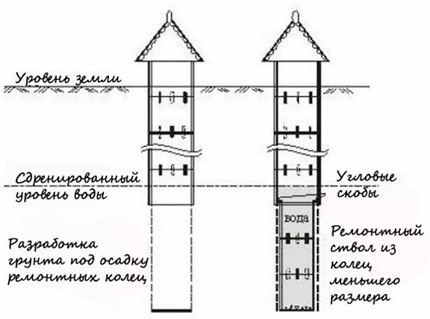
Well drilling at the bottom of the structure
This method involves well drilling followed by lowering the casing into it and installing the pump. Thus, the well, in fact, turns into a well. This is a fairly economical and easy way. The disadvantages include the need for regular cleaning of the newly drilled structure, which cannot be done without specialists.
In addition, a well located in a not very abundant formation will simultaneously produce a small amount of water. The problem can be solved by installing a special storage tank, but this will require additional effort and expense. Another “minus” - during the period of power outage, the well becomes inoperative.
Deepening a well with dismantling old rings
To implement the plan, you will need to remove all the old rings and expand the resulting pit. Then the structure deepens, and the rings are mounted again.
Experts consider this method the most inappropriate and even dangerous. First of all, dismantling the whole ring is unlikely to succeed. Most of the items below the third ring are likely to be damaged. So you have to buy new parts.
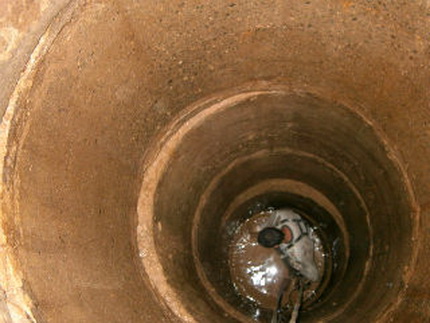
In addition, working in a well with not fortified walls is dangerous, if the depth of the structure exceeds 4-5 m, it is deadly.
Despite the claims of the “craftsmen" that the moist soil allegedly does not crumble, it can collapse at any moment without any obvious harbingers. To save a person who is at this moment at the bottom of the well will be extremely difficult, in some cases simply impossible.
Draft rings with cargo
After digging the shaft from below, the rings are sedimented with a load. This method can only be effective for a new well that was excavated no more than a couple of months ago. Otherwise, the soil managed to coalesce so that uniform subsidence of the shaft is impossible.
Most likely, there will be a rupture of the trunk, which will be almost impossible to fix. In addition, simple calculations show that the force that must be applied to the top of the column must be very large.
It is unlikely that it will be provided with a stone lid of the well. Even heavy equipment, for example, Kirovets with attachments, can be powerless. Although, as practice shows, he is able to push about 5 concrete rings with the right preparatory work.
Another caveat: the technique can crush the upper ring, so you need to do everything very carefully.
Extension of well walls from below
The method involves extracting the earth from under the old mine and strengthening the resulting walls with brickwork or concrete. In this way, the owners of the wells use, the rings of which are firmly “sitting” in the ground and it is impossible to precipitate them.
The method is quite viable, but laborious. If you intend to install masonry, you should especially carefully choose the material.
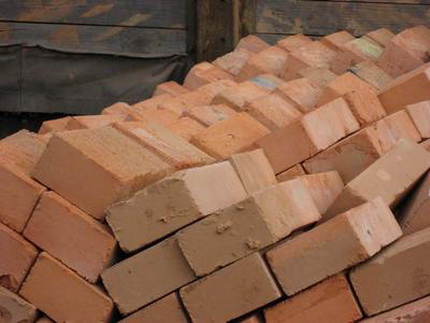
The so-called "burn", which is quite a lot, will crumble very quickly in a humid environment, which is unacceptable. If concrete is supposed to be used to strengthen the walls, you need to take care of its quality. It is absolutely impossible to save on cement. Reinforcement should also be of high quality. The main difficulty with concreting will be the inconvenience of such work.
In addition, the work will take a very long time, since it is dangerous to deepen the well in this way by more than 30-40 cm at a time. This is due to the fact that when digging a mine there is always a chance of a sudden subsidence of the column.
If by this moment a layer of concrete or brick is already built up, but it is still fresh and the cement has not had time to gain the required strength, the ring will easily break it. Thus, the work needs to be carried out only in several stages, 30-40 cm each, with mandatory breaks for cement hardening.
Deepening the design with repair rings
This is the most commonly used method of deepening wells. Masters caution against the mine method of conducting work when the assembled repair column is lowered by digging the soil from below. In this case, it can easily get stuck and bring it down will be very difficult.
It is optimal to perform step-by-step lowering of elements and perform all connections directly inside the well.
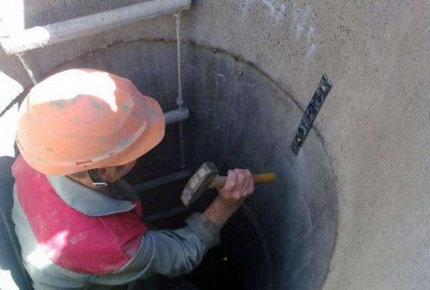
For work, we will need: a shovel with a short shank and an ordinary bayonet, a ladder, lighting equipment, a device for lifting the extracted soil to the surface, a winch, a jackhammer, a manual or electric drill, a level and a pump for pumping water.
Of materials, it is necessary to purchase repair rings of a smaller diameter than the ones in the well, a sealant for processing joints, staples and fittings for temporary fixation of parts. Let's analyze the process step by step.
Preparatory work
We start by inspecting the new rings and walls of the well.We check if there are any serious irregularities that may interfere with the descent of the structure.
We lower the drainage pump into the structure and completely pump out the water. From the exposed bottom we remove silt and deposits, we raise them to the surface. If there was a bottom filter in the well, remove all the backfill. We remove all soil saturated with water.
Once again, inspect the walls of the well. If they are very dirty, we carry out cleaning. We scrape off moss and deposits from the walls of concrete rings. If as a result of the inspection cracks and chips are revealed, we produce well wall repair and seams between the rings.
Now you can begin to strengthen them. To do this, we connect the joints of the rings with special brackets of at least 4 on each seam, which guarantees the immobility of the elements. Thus, we minimize the risk of deformation of the old column.

Directly deepening process
Start digging. We move from the center of the shaft to its edges. We continue to work until the walls of the pit begin to crumble under the pressure of incoming water from the outside.
After that we lower the repair rings to the bottom, building a new column. If the soil is prone to shedding, work should be done differently. In this case, we dig the shaft to a shallow depth, lower the first repair ring and temporarily fix it with reinforcement.
After that, we continue to work, taking out the soil from the inside of the structure and digging it. Gradually, the ring will settle, and it will be possible to put the following on it.
We fasten the rings together with brackets or corners. After the aquifer is reached, we close the joints with concrete mortar and seal them. We fasten the old and new columns together using brackets. We close the gap between the new and old rings with rubble.
Well finishing work
After the repair rings are installed in place, the final stage of work begins. It consists in examining the entire mine and identifying possible defects in the seams.
We carefully seal and seal them. Proceed to laying the bottom filter. This may be a new or even old filling, but in the latter case it must be thoroughly washed. Thereafter disinfect the well walls.
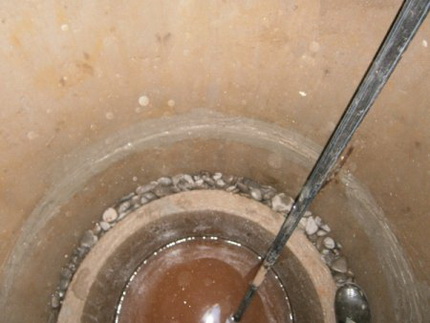
Digging a well
This method differs from the above in that the well is built up with repair rings from above. Moreover, their diameter does not differ from those that are already installed.
In fact, this is a continuation of the work begun many years ago at the initial digging a well. The main danger in using this method is the possibility of stuck old columns in the ground, especially if the well is located on clay rocks.
Preparatory work
We start by fixing the rings. At each junction we attach at least 4 staples. We drill holes for them, put metal plates 0.4x4x430 cm and fix them with 12 mm anchor bolts.
In this way, the casing can withstand possible movement of the soil. We pump out water from the well and completely remove the bottom filter, if it was present in the structure.
Deepening work
Down on the insurance, the worker goes down and starts to dig. First, he selects the soil from the middle of the bottom of the structure, then from the periphery. Then he begins to dig under two opposite points from the edges of the lower ring with a depth of 20-25 cm.
No longer needed, otherwise there is a danger of uncontrolled descent of the element. Then the undermining gradually expands to the annular region.
In the process, the column must settle under its own weight. New rings are put on the vacant place. Digging is carried out until the water begins to arrive very quickly.
It should be noted that the subsidence of the column does not always occur, especially if the well is “older” for 1-2 years. In difficult cases, you can use the lateral digging method, as a way to lower the stuck ring.
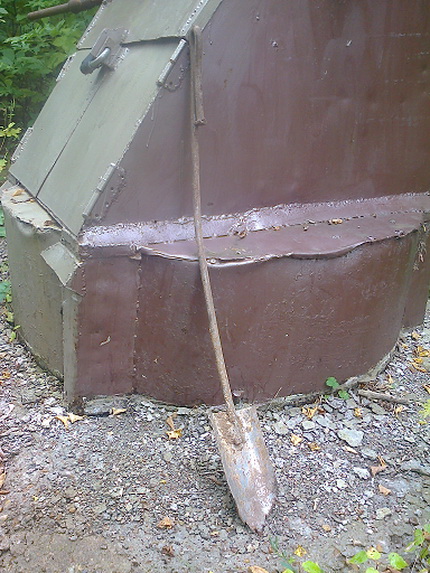
Consider it with the example of the lower ring. We do the digging as described above. Then we take three hemp or strong supports from the beam and install them under the ring so that between them and the bottom edge there is a distance of about 5 cm.
These supports will subsequently assume the brunt of the settled structure. Then, in two opposite areas, we remove the sealing solution from the inter-ring gap.
In the resulting gaps, insert the nail guns, and two people at the same time acting as a lever, they can try to lower the ring. If all else fails, take a special spatula for digging the side walls.
For its handle, fittings with a length of 10 cm and a diameter of 14 mm are used. The cutting part measuring 60x100 mm is made of 2 mm sheet iron. We insert a spatula 2-3 cm from the outer wall of the ring and proceed to gouging the clay.
To do this, hit the sledgehammer on the handle in the direction from the bottom up. Thus we pass the entire ring except for the areas under which the supports stand. We managed to remove the clay to a height of 10-15 cm from the bottom edge of the ring.
Now you can try again the attempt to lower with nail guns or any other levers. If it doesn’t work, take the next spatula. The length of her handle should be 10 cm longer. We perform similar actions.
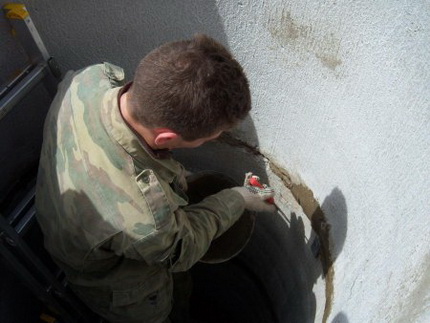
A small remark: when the length of the handle of the shovel reaches 40 cm or more, it will need to be slightly bent. So it will be more convenient to work. With proper side digging, the outer wall of the ring is gradually released, and it settles down. Similarly, work is carried out on other rings.
Final work in the well
Upon completion of the deepening work, all contaminated water is removed from the structure. All seams between the rings are securely sealed and sealed. If damaged old joints are noticed, they are also eliminated.
At the bottom of the structure we lay a new bottom filter of the desired design. Then we disinfect the walls of the mine with a solution of chlorine or manganese. The well is ready to use.
Do not forget that the normal operation of the water intake mine development and the preservation of its water mobility is directly related to competent arrangement, whose implementation rules will be introduced by our proposed article.
Conclusions and useful video on the topic
Video # 1. The process of deepening the well with repair rings:
Video # 2. How to operate, maintain and deepen the water source:
Video # 3. Is it always possible to deepen a well:
You can deepen a dry well in various ways. You need to choose one right, because you can carry out such work only once. A mistake will lead to useless money spending, as deepening the design is a very expensive undertaking. In terms of financial and labor costs, it is quite comparable to the digging of a new well.
Please write comments in the block below. Share your impressions and useful information on the topic of the article, ask questions. Tell us and visitors of the site about your experience in deepening water intake, post a photo.

 Do-it-yourself well cleaning: a review of the best preventative and capital methods
Do-it-yourself well cleaning: a review of the best preventative and capital methods  Digging a well with your own hands: types of well structures + an overview of the best digging technologies
Digging a well with your own hands: types of well structures + an overview of the best digging technologies  How to find water for a well: a review of effective aquifer search methods
How to find water for a well: a review of effective aquifer search methods 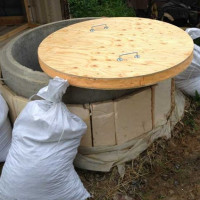 Do-it-yourself well warming for the winter: an overview of the best materials and methods of warming
Do-it-yourself well warming for the winter: an overview of the best materials and methods of warming 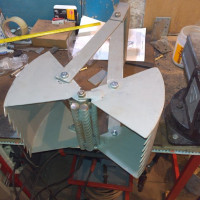 A review of the best tools for cleaning wells and how to use them
A review of the best tools for cleaning wells and how to use them 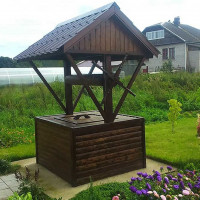 Do-it-yourself well arrangement at the cottage: step-by-step instruction + advice from experienced craftsmen
Do-it-yourself well arrangement at the cottage: step-by-step instruction + advice from experienced craftsmen  How much does it cost to connect gas to a private house: the price of organizing gas supply
How much does it cost to connect gas to a private house: the price of organizing gas supply  The best washing machines with dryer: model rating and customer tips
The best washing machines with dryer: model rating and customer tips  What is the color temperature of light and the nuances of choosing the temperature of the lamps to suit your needs
What is the color temperature of light and the nuances of choosing the temperature of the lamps to suit your needs  Replacement of a geyser in an apartment: replacement paperwork + basic norms and requirements
Replacement of a geyser in an apartment: replacement paperwork + basic norms and requirements
It happens that just the water leaves. In our village back in the 80s there was a stream in the middle of the village and water was in all wells. And now from the stream there was only a hollow covered with weeds and dry wells. Here you can dig 100 meters to the rock. Therefore, if the well is dry - it is not a fact that you will get to the bottom of the water. And this trend is observed throughout the Central Federal District.
Already deepened the well a year and a half ago, but the flow rate again fell. Should you bother with it and deepen further or will you have to dig a new well / well?
In this case, I can recommend going down to the well, of course, with all the insurances and the necessary equipment. Perform manual drilling a few meters to find out how much the water level has generally fallen. I think that it’s not difficult to get a manual drill or make it yourself. There are materials on the Web, as well as here on the resource on this issue.
If the water level fell by 1-2 meters, then it makes sense to deepen the well again, but if more, then the idea is dubious. For example, 3+ meters to a new water level, plus the expectation that the water level will fall again in the future, it turns out that it is not advisable to deepen the well.
In this case, digging a new well is not profitable, so there is only one option - to drill a well under water. Even if the water level drops in the well in the future, it will be easier to drill it deeper (immediately with a reserve) than to deepen the well once every 2-3 years.